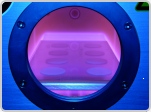The next technological challenge for the Solid-state lighting industry is the transition to silicon wafers. Everybody knows that silicon offers many advantages in terms of cost and availability. Nevertheless, the changeover bears many risks. In the end, different business models for the processing of LED wafers could emerge.

At the LpS Symposium in Bregenz, the topic of LED wafers based on silicon instead of today's widely used sapphire as the substrate material was discussed as a part of a presentation block headlined "Disruptive Technologies". Nevertheless, more or less every LED manufacturer (save Cree, who utilizes SiC materials) is preparing a switchover to silicon. The reasons are simple: Silicon wafers offer vast cost advantages over sapphire - manufacturers could then utilize mature, efficient, widely automated processes with high yield. "Silicon is cheaper than sapphire and will likely remain so", explained Pars Mukish, analyst with Yole Développement. Moreover, the processing infrastructure for silicon wafers anticipates and supports larger diameters - in silicon, manufacturers could work with 200mm wafers, while sapphire wafers do not exceed 150mm; in most cases the industry still works with 4" or even 2" wafers - and an inherently lower productivity. What's more, silicon offers better thermal conductivity and thus better temperature homogeneity whit the possible consequence of an improved binning and better yield.
All these divergent properties eventually would translate into much better price for silicon-based LEDs. Mukish expects an improvement at a factor of ten over 2" sapphire - and the processing costs make up some 55 percent of the total cost of a packaged LED. Being able to significantly reducing the processing cost thus would be something like LED manufacturer's heaven. But before the industry can go up there, they have to resolve a number of technical challenges. The list of problems connected to the use of silicon as substrate material for LEDs is long. In order to discuss these problems, it is important to remember that in both cases - sapphire substrate as well as silicon substrate - the LED functions are implemented on top of the substrate - the epitaxial LED functions are grown as a GaN stack on top of the substrate. Silicon and GaN however have rather different thermal coefficients of expansion (TCE). For this reason, the likelihood for stress cracks is rising with silicon. There is a workaround: Process engineers will add strain management layers to get rid of the problem. These layers make the process more complex - not very much, but at an extend that is not negligible.
Another problem with silicon is that it has its relatively poor light properties compared to sapphire. While sapphire is transparent, silicon would absorb most of the light generated by the LED, which would decrease the efficiency of the entire device. For this reason, the substrate has to be removed after the creation of the GaN stack - which in turn eats up some of the price advantage. As an alternative, a Distributed Bragg Reflector (DBR) mirror could be inserted between substrate and light emitting layer, but this would be a complex operation.
Against the background of such trade-off issues, it would be likely that the some players will move away from today's prevailing business model of processing the entire wafer, the analyst explained. Instead, some players might sell semi-processed epiwafers with a GaN stack on top of the silicon substrate to CMOS processing foundries interested in entering the LED value chain. Other fragmentations of the value chain could be possible as well.
In any case, more or less the entire LED industry currently is watching all others, silently preparing that someone starts with the changeover to silicon. So far, only Bridgelux and Lattice Power have openly committed to the transition. Even a different business model could be realistic: The fabless LED provider who outsources the entire wafer production, Mukish said.





